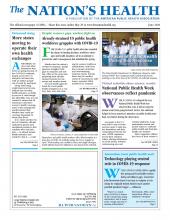
Expressing creativity and appreciating art can be beneficial for mental and physical health.
Photo by DragonImages, courtesy of iStockphoto
When you think of activities that are good for your health, you may picture eating vegetables or taking a walk. Or maybe you think of getting enough sleep, spending time with family or staying up on your vaccinations.
Those are all great, healthy things, but there’s another less-often-cited activity that can also help keep you healthy: Engaging in art.
Humans are built to both be creative and to appreciate creativity. That is why we’re all drawn to art in some form or another — from paintings to music to dance. A huge body of research shows that art can promote both physical and mental health, including wellness and healing:
• Art can help keep your brain sharp as you age. Playing music and dancing can help boost cognitive health. Taking in a museum or opera performance every few months has been found to lower risk of dementia.
• Dancing helps keep your body healthy. It improves your posture and flexibility. It can also help reduce risk of falls.
• Having a healthy intake of art has even been found to reduce chances of premature death overall. Being engaged with culture often leads to less sedentary behaviors, depression and cognitive decline.
Fortunately, you don’t have to be a skilled painter or musician to get the health benefits of art. If you want to express yourself creatively, the main thing is finding what engages you.
A good place to start is thinking about what you liked to do as a kid, says Heather Stuckey, DEd, an assistant professor at Penn State who has researched the links between art and health. Did you like making things out of Play-Doh? Banging on a xylophone? Or maybe you drew crayon masterpieces that were posted on your parents’ fridge.
Adults can still play with those tools from childhood, or translate them for their grown-up lives. Play-Doh fans can try a pottery class and budding musicians can take some lessons. Coloring books for adults, featuring more complex patterns than the ones you used when you were a kid, are a great way to both unwind and express yourself.
And if you want to color outside the lines, go for it!
“When we talk about art and health, it’s not about following the rules, it’s about creative expression,” Stuckey says.
Art doesn’t have to just be about making or doing something. Appreciating art is also good for your health. Even if painting isn’t a thing you like to do, it might still be relaxing to watch Bob Ross break out the titanium white to make happy little clouds. If you’re feeling stuck, take time to look at, listen to or watch some art. You may find that you quickly feel more calm or rejuvenated.
“Even if I can’t pick up a guitar and play it, I can still connect with it through listening,” Stuckey says. “It can still inspire me.”
Music is a well-established tool for helping people find comfort or strength. Music therapy is used to help people feel better when they’re in pain. It can improve breathing, lower blood pressure and heart rate, and relax muscles. And all of these soothing benefits can decrease your risk of developing hypertension. And if you want to up those health benefits, add a little bit of dancing in with your music.
Art has been shown to have an impact on the brain. Music and therapy dance are used to both treat depression and anxiety. Children who have experienced trauma can find support for grief, depression and PTSD through art. And art therapy can help people with severe mental illnesses find a sense of well-being.
While art therapy can help a lot of people in different ways, benefits don’t have to be confined to a therapists’ office, Stuckey says. Art happens in schools, hospitals, living rooms and more places.
Art can also connect people. Singing alone is great, but it’s even better to sing in a group. And singing to babies can improve the bond between parents and children.
Feeling inspired? Go online and sign up for a class or a group. Find a knitting club or a local open mic night and meet some of your local performers and music-loving neighbors. Art just might change both your health and your life.
- Copyright The Nation’s Health, American Public Health Association









